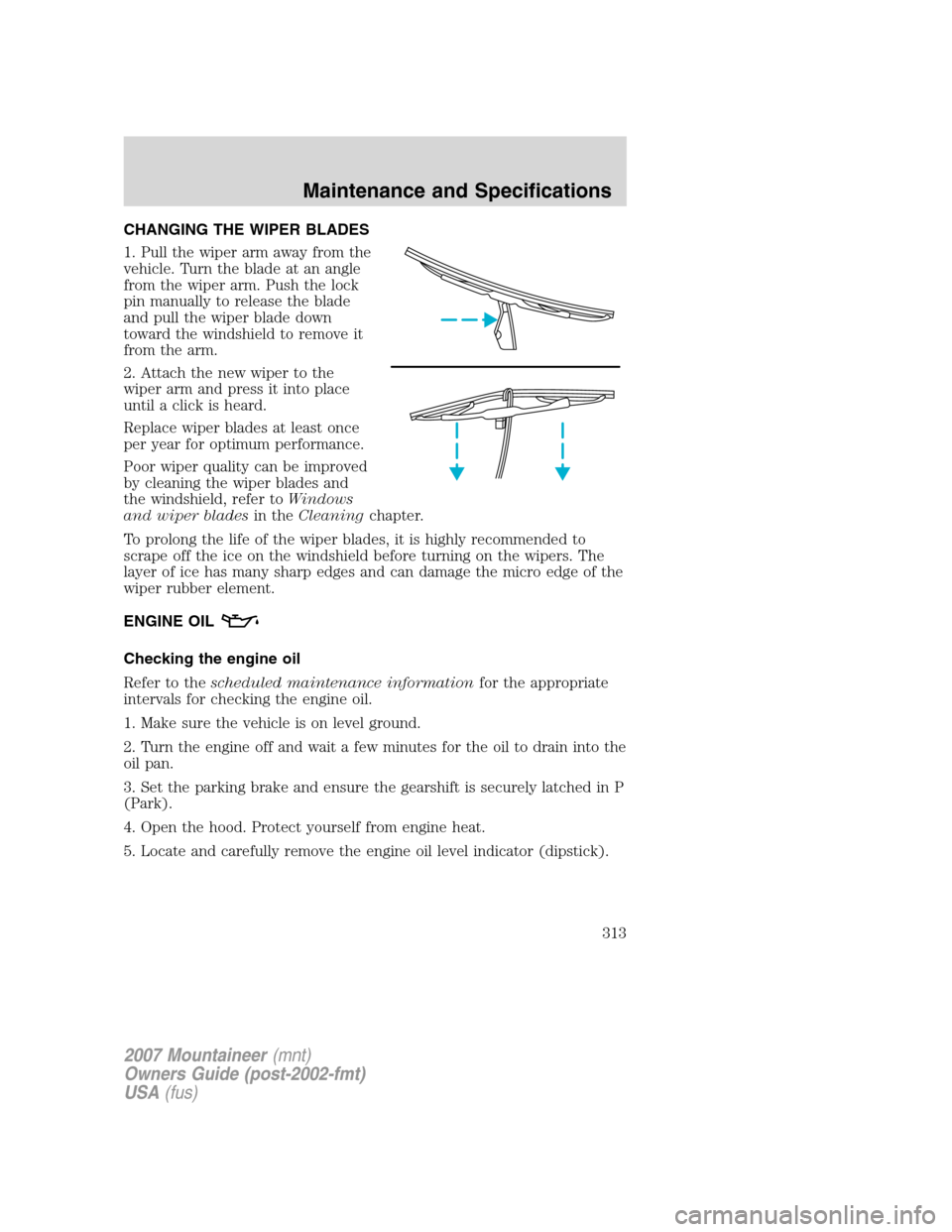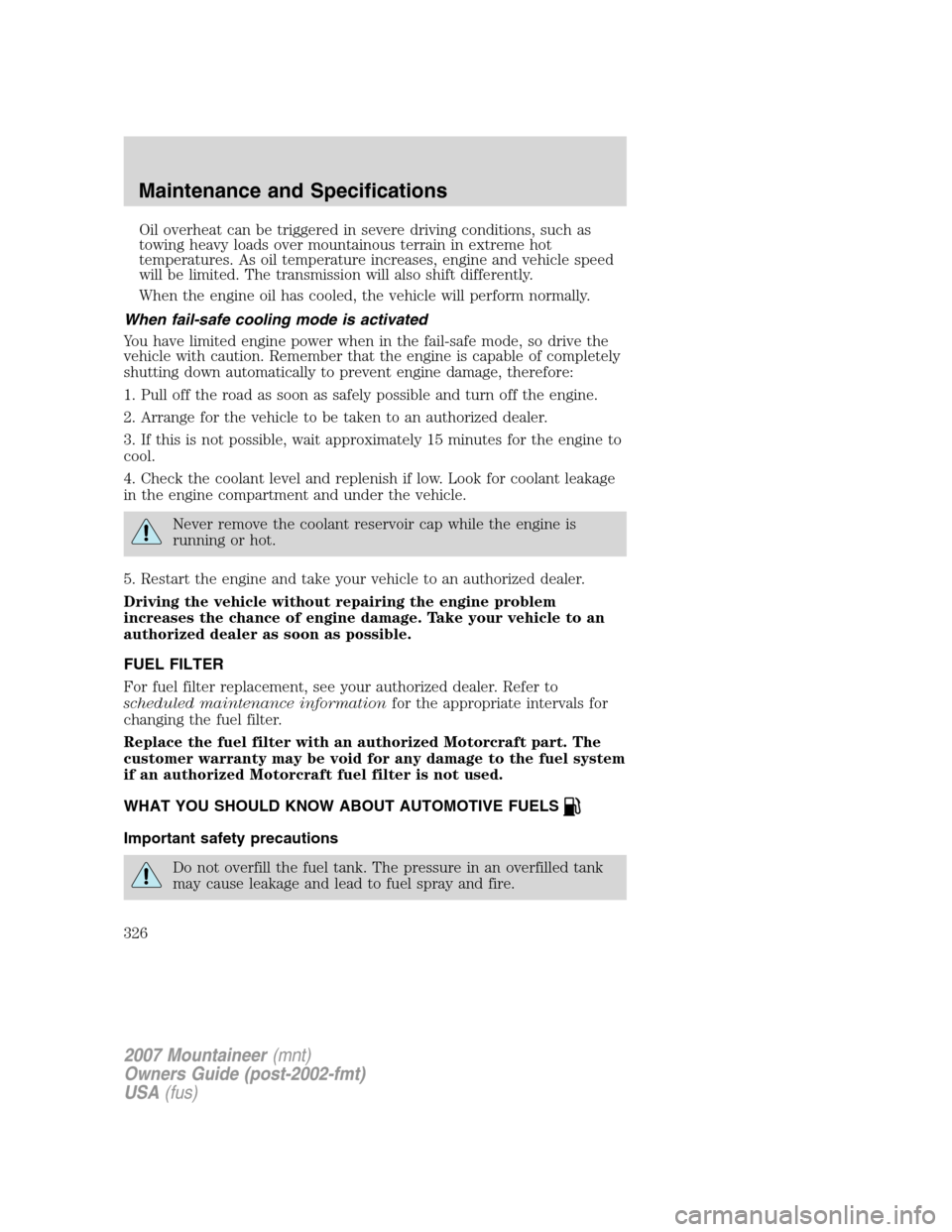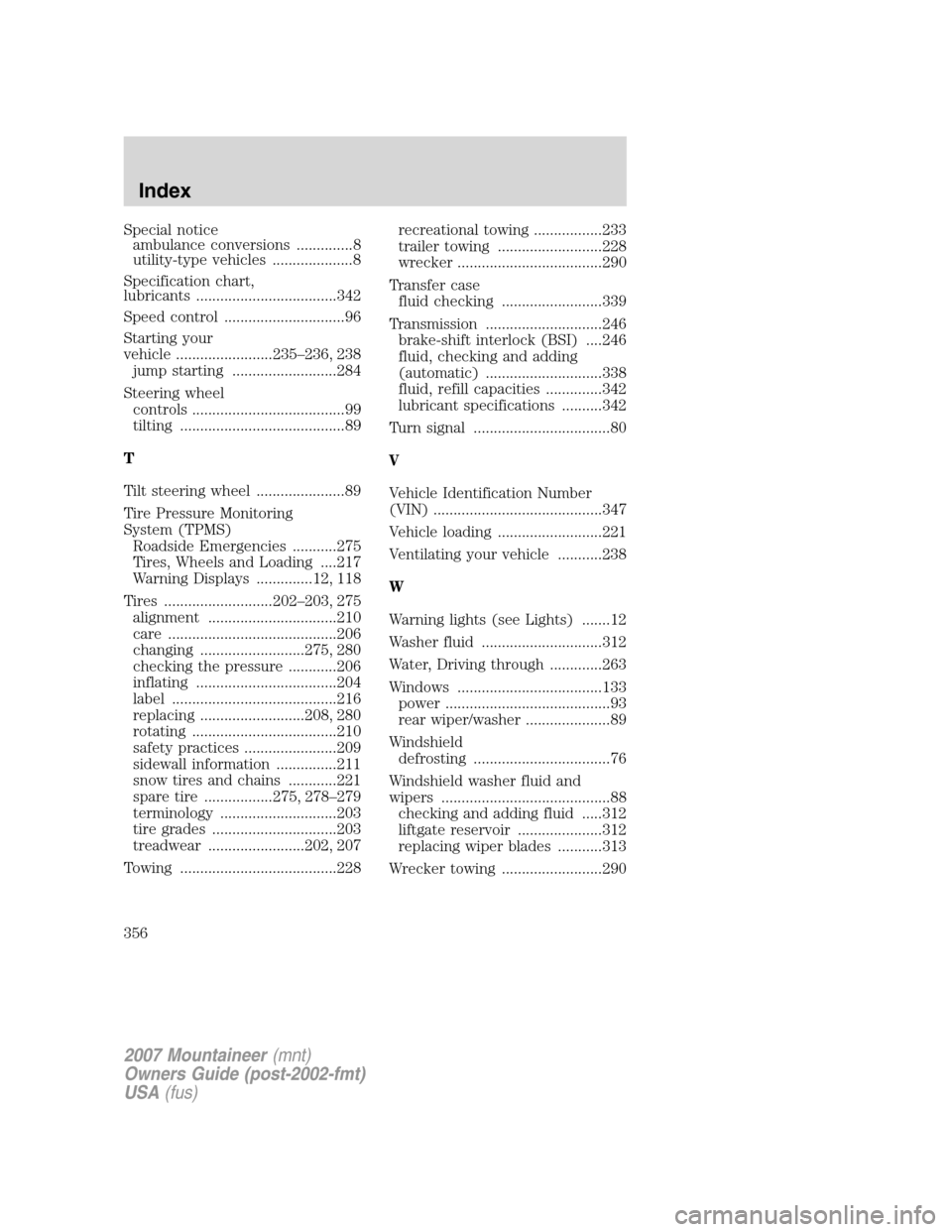tow Mercury Mountaineer 2007 s Repair Manual
[x] Cancel search | Manufacturer: MERCURY, Model Year: 2007, Model line: Mountaineer, Model: Mercury Mountaineer 2007Pages: 360, PDF Size: 3.36 MB
Page 313 of 360

CHANGING THE WIPER BLADES
1. Pull the wiper arm away from the
vehicle. Turn the blade at an angle
from the wiper arm. Push the lock
pin manually to release the blade
and pull the wiper blade down
toward the windshield to remove it
from the arm.
2. Attach the new wiper to the
wiper arm and press it into place
until a click is heard.
Replace wiper blades at least once
per year for optimum performance.
Poor wiper quality can be improved
by cleaning the wiper blades and
the windshield, refer toWindows
and wiper bladesin theCleaningchapter.
To prolong the life of the wiper blades, it is highly recommended to
scrape off the ice on the windshield before turning on the wipers. The
layer of ice has many sharp edges and can damage the micro edge of the
wiper rubber element.
ENGINE OIL
Checking the engine oil
Refer to thescheduled maintenance informationfor the appropriate
intervals for checking the engine oil.
1. Make sure the vehicle is on level ground.
2. Turn the engine off and wait a few minutes for the oil to drain into the
oil pan.
3. Set the parking brake and ensure the gearshift is securely latched in P
(Park).
4. Open the hood. Protect yourself from engine heat.
5. Locate and carefully remove the engine oil level indicator (dipstick).
2007 Mountaineer(mnt)
Owners Guide (post-2002-fmt)
USA(fus)
Maintenance and Specifications
313
Page 326 of 360

Oil overheat can be triggered in severe driving conditions, such as
towing heavy loads over mountainous terrain in extreme hot
temperatures. As oil temperature increases, engine and vehicle speed
will be limited. The transmission will also shift differently.
When the engine oil has cooled, the vehicle will perform normally.
When fail-safe cooling mode is activated
You have limited engine power when in the fail-safe mode, so drive the
vehicle with caution. Remember that the engine is capable of completely
shutting down automatically to prevent engine damage, therefore:
1. Pull off the road as soon as safely possible and turn off the engine.
2. Arrange for the vehicle to be taken to an authorized dealer.
3. If this is not possible, wait approximately 15 minutes for the engine to
cool.
4. Check the coolant level and replenish if low. Look for coolant leakage
in the engine compartment and under the vehicle.
Never remove the coolant reservoir cap while the engine is
running or hot.
5. Restart the engine and take your vehicle to an authorized dealer.
Driving the vehicle without repairing the engine problem
increases the chance of engine damage. Take your vehicle to an
authorized dealer as soon as possible.
FUEL FILTER
For fuel filter replacement, see your authorized dealer. Refer to
scheduled maintenance informationfor the appropriate intervals for
changing the fuel filter.
Replace the fuel filter with an authorized Motorcraft part. The
customer warranty may be void for any damage to the fuel system
if an authorized Motorcraft fuel filter is not used.
WHAT YOU SHOULD KNOW ABOUT AUTOMOTIVE FUELS
Important safety precautions
Do not overfill the fuel tank. The pressure in an overfilled tank
may cause leakage and lead to fuel spray and fire.
2007 Mountaineer(mnt)
Owners Guide (post-2002-fmt)
USA(fus)
Maintenance and Specifications
326
Page 331 of 360

Running out of fuel
Avoid running out of fuel because this situation may have an adverse
effect on powertrain components.
If you have run out of fuel:
•You may need to cycle the ignition from OFF to ON several times after
refueling to allow the fuel system to pump the fuel from the tank to
the engine. On restarting, cranking time will take a few seconds longer
than normal.
•Normally, adding one gallon of fuel is enough to restart the engine. If
the vehicle is out of fuel and on a steep grade, more than one gallon
may be required.
•The
indicator may come on. For more information on the “check
engine” or the “service engine soon” indicator, refer toWarning lights
and chimesin theInstrument Clusterchapter.
ESSENTIALS OF GOOD FUEL ECONOMY
Measuring techniques
Your best source of information about actual fuel economy is you, the
driver. You must gather information as accurately and consistently as
possible. Fuel expense, frequency of fill-ups or fuel gauge readings are
NOT accurate as a measure of fuel economy. We do not recommend
taking fuel economy measurements during the first 1,000 miles (1,600 km)
of driving (engine break-in period). You will get a more accurate
measurement after 2,000 miles-3,000 miles (3,000 km–5,000 km).
Filling the tank
The advertised fuel capacity of the fuel tank on your vehicle is equal to
the rated refill capacity of the fuel tank as listed in theMaintenance
product specifications and capacitiessection of this chapter.
The advertised capacity is the amount of the indicated capacity and the
empty reserve combined. Indicated capacity is the difference in the
amount of fuel in a full tank and a tank when the fuel gauge indicates
empty. Empty reserve is the small amount of fuel remaining in the fuel
tank after the fuel gauge indicates empty.
The amount of usable fuel in the empty reserve varies and should
not be relied upon to increase driving range. When refueling your
vehicle after the fuel gauge indicates empty, you might not be
able to refuel the full amount of the advertised capacity of the
fuel tank due to the empty reserve still present in the tank.
2007 Mountaineer(mnt)
Owners Guide (post-2002-fmt)
USA(fus)
Maintenance and Specifications
331
Page 333 of 360

Habits
•Smooth, moderate operation can yield up to 10% savings in fuel.
•Steady speeds without stopping will usually give the best fuel
economy.
•Idling for long periods of time (greater than one minute) may waste
fuel.
•Anticipate stopping; slowing down may eliminate the need to stop.
•Sudden or hard accelerations may reduce fuel economy.
•Slow down gradually.
•Driving at reasonable speeds (traveling at 55 mph [88 km/h] uses
15% less fuel than traveling at 65 mph [105 km/h]).
•Revving the engine before turning it off may reduce fuel economy.
•Using the air conditioner or defroster may reduce fuel economy.
•You may want to turn off the speed control in hilly terrain if
unnecessary shifting between the top gears occurs. Unnecessary
shifting of this type could result in reduced fuel economy.
•Warming up a vehicle on cold mornings is not required and may
reduce fuel economy.
•Resting your foot on the brake pedal while driving may reduce fuel
economy.
•Combine errands and minimize stop-and-go driving.
Maintenance
•Keep tires properly inflated and use only recommended size.
•Operating a vehicle with the wheels out of alignment will reduce fuel
economy.
•Use recommended engine oil. Refer toMaintenance product
specifications and capacitiesin this chapter.
•Perform all regularly scheduled maintenance items. Follow the
recommended maintenance schedule and owner maintenance checks
found inscheduled maintenance information.
Conditions
•Heavily loading a vehicle or towing a trailer may reduce fuel economy
at any speed.
•Carrying unnecessary weight may reduce fuel economy (approximately
1 mpg [0.4 km/L] is lost for every 400 lb [180 kg] of weight carried).
2007 Mountaineer(mnt)
Owners Guide (post-2002-fmt)
USA(fus)
Maintenance and Specifications
333
Page 356 of 360

Special notice
ambulance conversions ..............8
utility-type vehicles ....................8
Specification chart,
lubricants ...................................342
Speed control ..............................96
Starting your
vehicle ........................235–236, 238
jump starting ..........................284
Steering wheel
controls ......................................99
tilting .........................................89
T
Tilt steering wheel ......................89
Tire Pressure Monitoring
System (TPMS)
Roadside Emergencies ...........275
Tires, Wheels and Loading ....217
Warning Displays ..............12, 118
Tires ...........................202–203, 275
alignment ................................210
care ..........................................206
changing ..........................275, 280
checking the pressure ............206
inflating ...................................204
label .........................................216
replacing ..........................208, 280
rotating ....................................210
safety practices .......................209
sidewall information ...............211
snow tires and chains ............221
spare tire .................275, 278–279
terminology .............................203
tire grades ...............................203
treadwear ........................202, 207
Towing .......................................228recreational towing .................233
trailer towing ..........................228
wrecker ....................................290
Transfer case
fluid checking .........................339
Transmission .............................246
brake-shift interlock (BSI) ....246
fluid, checking and adding
(automatic) .............................338
fluid, refill capacities ..............342
lubricant specifications ..........342
Turn signal ..................................80
V
Vehicle Identification Number
(VIN) ..........................................347
Vehicle loading ..........................221
Ventilating your vehicle ...........238
W
Warning lights (see Lights) .......12
Washer fluid ..............................312
Water, Driving through .............263
Windows ....................................133
power .........................................93
rear wiper/washer .....................89
Windshield
defrosting ..................................76
Windshield washer fluid and
wipers ..........................................88
checking and adding fluid .....312
liftgate reservoir .....................312
replacing wiper blades ...........313
Wrecker towing .........................290
2007 Mountaineer(mnt)
Owners Guide (post-2002-fmt)
USA(fus)
Index
356